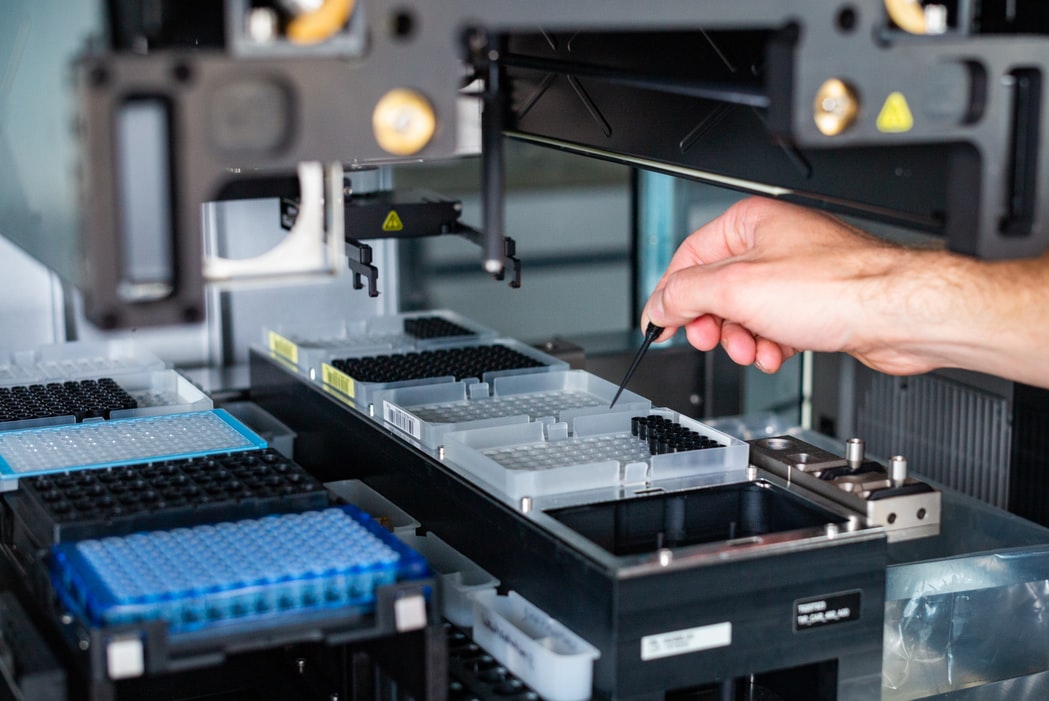Ramping Production Is No Easy Feat
 Robotic testing machine in drug manufacturing. Credit: Aleks Marinkovic
Robotic testing machine in drug manufacturing. Credit: Aleks Marinkovic
No matter the manufacturing process, starting a next generation line or scaling a pre-existing process is extremely difficult. Just ask Tesla or Intel. Elon Musk even suggests to not buy a Tesla car when they are ramping up production due to quality issues. Both upstart manufacturers and incumbent players take on big risks technically and financially to launch new manufacturing capacity. That’s why the use of the Defense Production Act and Operation Warp Speed were so critical to maximizing our chances to mass produce a COVID-19 vaccine and be able to inoculate the population before the virus mutates.
Unlike some verticals, pharmaceutical manufacturing requires the utmost precision and process traceability “so that every dose is safe and effective, and free of contamination and defects”, as stated by the FDA’s Office of Pharmaceutical Quality. That’s why a mix-up at an Emergent BioSolutions facility, which produces Johnson & Johnson’s vaccine, is a bit alarming. While yield issues usually occur due to the complexities of the manufacturing process, the conflation of ingredients on a high-profile program is an unnecessary step back to get doses out the door and into arms. At the very least, additional partners such as Merck can adapt their vaccine manufacturing lines to produce the more traditional Johnson & Johnson vaccine.
In the case of Pfizer’s and Moderna’s mRNA based COVID-19 vaccines, large-scale production has never happened before. Pfizer estimates spending over $2 billion on the program for product development and machinery to produce a prospective efficacious vaccine. Once approved, the challenges throughout the rest of the supply chain also began for producing the protective coating of the mRNA, the liquid nanoparticles, as well as vials and freezers for storing the vaccine doses before injection. All of this required incredible human coordination and technological prowess to go from lab to jab in under a year.
The ultimate promise of Industry 4.0 technologies is enabling capital efficient scaling for manufacturing enterprises. Envision an ecosystem of rapid prototyping in a cloud simulation environment, using specialized process capabilities offered at little to no cost through APIs, tinkering until you get it right, and then pushing a few buttons to synchronize it directly to a local factory with available robots and machinery that self-learn the best way to manufacture. An ecosystem like this is what we have today in the cloud software business and if brought to the physical goods world it will significantly reduce the risk and resources required to ramp an industrial business. Cloud software platforms and e-commerce startups flourished post Amazon Web Services launch due to the flexibility of ramping up and down computing needs while also reducing the friction to getting started. Industry 4.0 maturity could trigger a similar inflection point for manufacturing startups. History is littered with manufacturing innovators facing bankruptcy due to the capital intensive nature of manufacturing. Imagine the possibilities for business innovation (i.e. Tesla) and human progress (i.e. novel vaccines) when Industry 4.0 comes to fruition reducing the barriers to entry and scale.
Visual Inspection
How to build a predictive maintenance solution using Amazon SageMaker
Acoustic Monitoring
Assembly Line
Stretch Is Boston Dynamics' Take on a Practical Mobile Manipulator for Warehouses
Boston Dynamics is announcing Stretch, a mobile robot designed to autonomously move boxes around warehouses. At first glance, you might be wondering why the heck this is a Boston Dynamics robot at all, since the dynamic mobility that we associate with most of their platforms is notably absent. The combination of strength and speed in Stretch’s arm is something we haven’t seen before in a mobile robot, and it’s what makes this a unique and potentially exciting entry into the warehouse robotics space.
Adversarial training reduces safety of neural networks in robots
A more fundamental problem, also confirmed by Lechner and his coauthors, is the lack of causality in machine learning systems. As long as neural networks focus on learning superficial statistical patterns in data, they will remain vulnerable to different forms of adversarial attacks. Learning causal representations might be the key to protecting neural networks against adversarial attacks. But learning causal representations itself is a major challenge and scientists are still trying to figure out how to solve it.
How Additive Manufacturing Adoption Brings Business Gains
Analysis from Jabil’s 2021 3D Printing Technology Trends survey revealed that additive manufacturing is already enabling unique and better ways for manufacturers to serve their markets. In the last few years, highly regulated industries with precise and rigid standards for safety and quality, such as healthcare, aerospace, defense and automotive, have positioned themselves enthusiastically among those championing the strategic benefits of additive manufacturing.
AI tool locates and classifies defects in wind turbine blades
Using image enhancement, augmentation methods and the Mask R-CNN deep learning algorithm, the system analyses images, highlights defect areas and labels them.
After developing the system, the researchers tested it by inputting 223 new images. The proposed tool is said to have achieved around 85 per cent test accuracy for the task of recognising and classifying wind turbine blade defects.
How To Measure ML Model Accuracy
Machine learning (ML) is about making predictions about new data based on old data. The quality of any machine-learning algorithm is ultimately determined by the quality of those predictions.
However, there is no one universal way to measure that quality across all ML applications, and that has broad implications for the value and usefulness of machine learning.
Surge Demand
In case you missed it, the Ever Given is now dislodged from the banks of the Suez. Automotive companies continue to face chip shortages causing halts to production. The digital transformation of industrial conglomerates heats up with Hitachi buying GlobalLogic. Reinforcement learning continues to move beyond games and into the real world.
